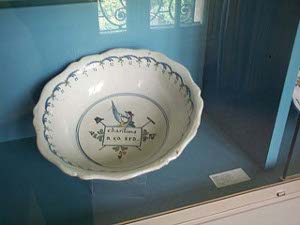 The Carnavelet museum
The Carnavelet museum
The Carnavelet Museum, called the Museum of the History of Paris, is housed in two elegant old mansions, one of which was owned by the Countess de Sevigny, who entertained the leading social and intellectual personages of the 18th century.
 The Carnavelet museum
The Carnavelet museum
What we found was the history of the city as expressed in its architecture, objects and art. While we certainly enjoyed the intrinsic beauty of the art and decor, we failed to learn as much about the history of the city as we had hoped. This was because, except for the period of the French Revolution, the explanatory signs were quite sparse, generally just naming the artist, the date, and perhaps the subject. Somewhat later on we tumbled to the fact that this was a museum of historical art rather than a museum of history. We conjecture that the art museums of Paris have evolved by taking the enormous national accumulation of works of art and museum pieces and divvying it up among various museums -- the Louvre for classical art, the Orsay for the impressionists, the Pompidou for modern art, the Carnavalet for historical art, the Cluny for mediaeval art, etc.
From its earliest days, Paris was considered an interesting and economically important European city, with many artists capturing newly-built buildings and special events (e.g., the arrival of the Venetian ambassador, with royal coaches lined up in front of the Louvre Palace, sometime in the 1500s.) As the city gained in stature and importance, the rich and powerful moved in, built and decorated large homes, and entertained each other. Throughout our walk through the museum's corridors, we found repeated rooms of Paris As Seen by Painters, showing the gradual change to bustling streets, and the beginnings of motorized travel.
 A! Ca ira - French Revolution
A! Ca ira - French Revolution
The best part of the Carnavalet is the section devoted to the years of the French Revolution. A rich collection of objects from those horrible years has been assembled, from flags to pottery to the room where the royal family was held during one of their imprisonments. There are models, made at that time, of the new invention the Guillotine, as well as a portrait of its inventor looking smug. There are medals to M. Necker, the finance minister. There are pottery bowls and platters with revolutionary slogans. At the very beginning of the exhibits, we had passed fragments of one of the first royal statues to be erected in Paris; it was smashed during the days of the Terror, along with just about every other royal statue existing at the time. The cumulative effect is chilling, because the Revolution had so much tearing down and so little building up.
The later exhibits featuring Napoleon also contain some well-preserved items, like his dress armor and some of his weapons, and we're sure the museum would be extremely fascinating and moving to one already versed in French history. Again we guessed about the motives of the museum designers: we felt it was designed primarily for the French citizen, who could be expected to have a thorough grounding in French History through the lycees, and not for the tourist (or immigrant) who needed to have things explained in more detail -- namely, why were these people important. We regretted that our 1958 major  Proust's bedroom
in French Literature laid so little stress on history. But of course we did respond to the exhibits showing the rooms belonging to some of Paris' famous artists and writers, such as Marcel Proust, who settled in a small room to write the 17 or so volumes of A La Recherche du Temps Perdu. He lined the walls with cork to help keep out noise, and created a little hideaway which is both cosy and claustrophobic.
Proust's bedroom
in French Literature laid so little stress on history. But of course we did respond to the exhibits showing the rooms belonging to some of Paris' famous artists and writers, such as Marcel Proust, who settled in a small room to write the 17 or so volumes of A La Recherche du Temps Perdu. He lined the walls with cork to help keep out noise, and created a little hideaway which is both cosy and claustrophobic.
The proof of our conjectures about the Carnavalet Museum came during our visit to the museum store, which featured shelf upon shelf of books about French art and architecture, but virtually nothing at all about the history of France or Paris. Irritated by our own stupidity, we have vowed to make a study of French history and politics, even if we have to use texts in English.
We rounded out our day with a pleasant walk in the Marais neighborhood, a long stare at a clutch of pigeons going berserk over (we think) scattered salt, and a late lunch at Cafe Leon, a French chain restaurant featuring farm-grown mussels prepared in a variety of sauces. Yummy! (As we dug into our bowls of mussels, we watched the man at the table next to us. He ordered first one plate of mussels prepared with cheeses and other ingredients, and liked it so well he ordered a second plate. We admired his energy and confidence.)